Past in English Language
The 4 Past Tenses
A - simple past tense
The simple past tense is used to describe a completed activity that started in the past and ended in the past.
Example: I went to work.
Example: The Martians landed near the aqueduct.
| Note: Use the simple past tense to express a habit in the past, and not the past continuous. |
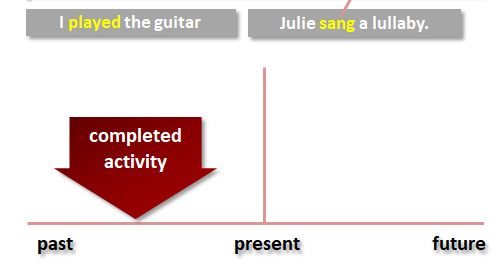
B - past progressive tense
Use the past continuous tense to describe events in the past happening at the time another action took place:
Note: Use the past continuous tense to describe events in the past happening at the time another action took place. |
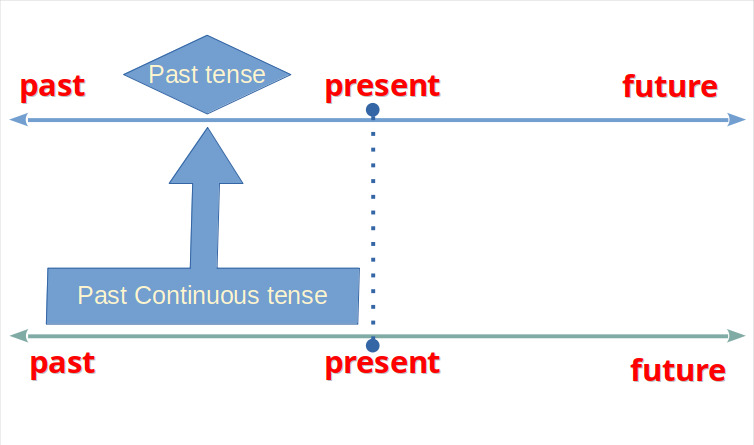
The past progressive tense is used to describe an ongoing activity in the past. Often, it is used to set the scene for another action.
| Non-action verbs are used to describe states, senses, desires, possession, emotions and opinion. Non-action verbs are not usually used in continuous tenses. |
| Examples: |
|---|
I was walking to school when I met him. |
I was going to work. |
We were painting the door when a bird struck the window. |
C - past perfect tense
The past perfect is used to demonstrate an action that occurred before another action in the past. There are usually two completed actions in the sentence; one happens before the other.
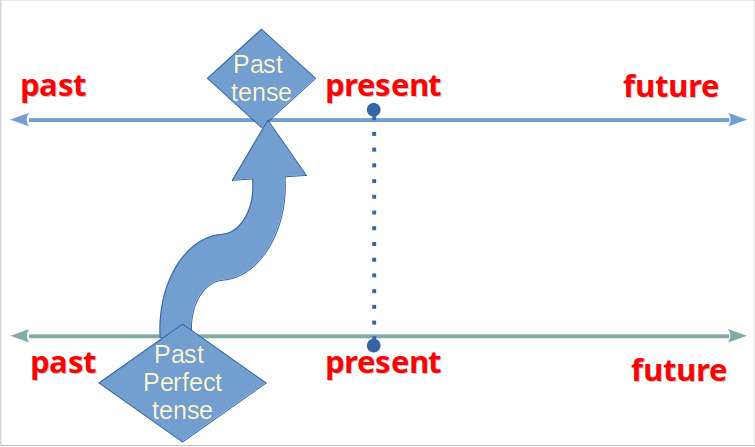
The past perfect tense is used to emphasize that an action was completed before another took place.
| Note: When can be used in place of before or after in any of the above structures. |
| Examples: |
|---|
I went to the office after I had finished some business with her. |
Alex had completed the task before the teacher asked. |
I had bought a phone before you came here. |
She had been painting the door before the dog scratched it. |
I had gone to work. |
Rover had eaten the pie before we got home. |
D - past perfect progressive
The past perfect progressive tense is an extension to the past perfect tense and its structures. Past perfect progressive is used to demonstrate an action which continued for a specific period of time but stopped before another action.
| Note: Non-action verbs are used to describe states, senses, desires, possession, emotions and opinion. Non-action verbs are not usually used in continuous tenses. |
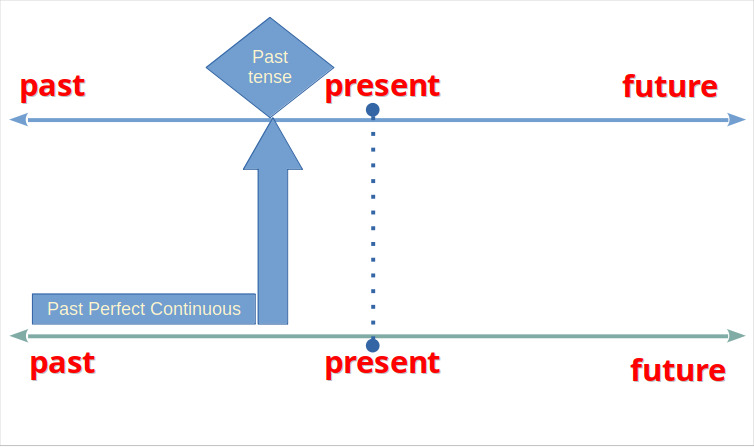
The past perfect progressive tense is used to show that an ongoing action in the past has ended.
| Note: This tense can be replaced by the past perfect tense withdrawing for/since. |
| Examples: |
|---|
Alan had been playing cricket for 18 years before he retired. |
Jack had been living in Sydney since 2010 before he moved to Melbourne. |
I had been going to work. |
She had been painting the door before the dog scratched it. |
They had been playing football in that field before it started to rain. |
Jane had been gossiping in the coffee shop for two hours. |
Jeff had been studying in the library before he came to the class. |
We had been shopping in that shop before we came home. |
E - used to
We use the structure used to do something when we talk about something we did regularly in the past, but do not do it now. Used to is different to the past simple because it emphasizes that the action was repeated many times. We also use used to + the infinitive for past situations. It emphasizes that the situations are no longer true. Used to expresses a past state or habit and it usually refers to some old situation which no longer exists.
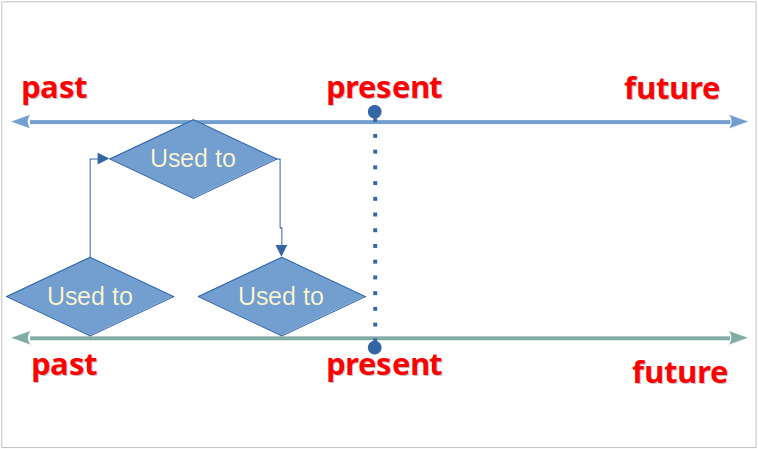
| Examples: |
|---|
He used to go to our school. |
She used to be overweight but became she a model last year. |
I used to see him every day. |
My father used to play football very well. |
F - could
Could is sometimes used as the past of can. could for past ability. Could is a verb with many senses. Could is the past tense of can, a verb used to denote ability. In this sense, could refers to some ability that someone had in the past. could is being used to express an ability that the speaker had in the past. We use could to talk about what was ability in the past, what we were able or free to do:
Could is the past tense of can.
If you are looking to make a statement of ability, think to yourself, “I can do that.”
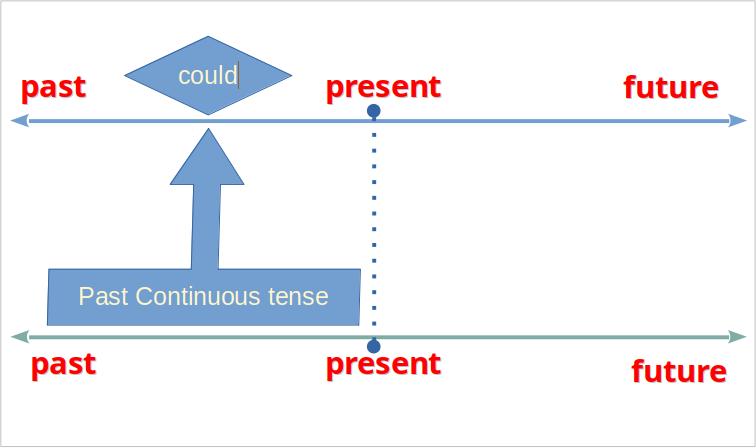
In high school, I `could` do my homework on the bus.
As you can see, could is simply making a statement of ability. When I was in high school, I could do my homework on the bus. I had the ability to do my homework on the bus, but this doesn’t mean that I did. I simply had the ability to do so.
| Examples: |
|---|
I could swim when I was 5 years old. |
My grandmother could speak seven languages. |
When we arrived home, we could not open the door. (…couldn’t open the door.) |
Could you understand what he was saying? |
When I was younger I could play tennis very well. |
In high school, I could dunk a basketball. |
In my prime, I could bench press 250 pounds. |
Could is a conditional verb that expresses possibility.
Could is also the past tense of can.
G - would
Would is also a verb with many senses.
Would is the past tense of will, which denotes both ability and certainty.
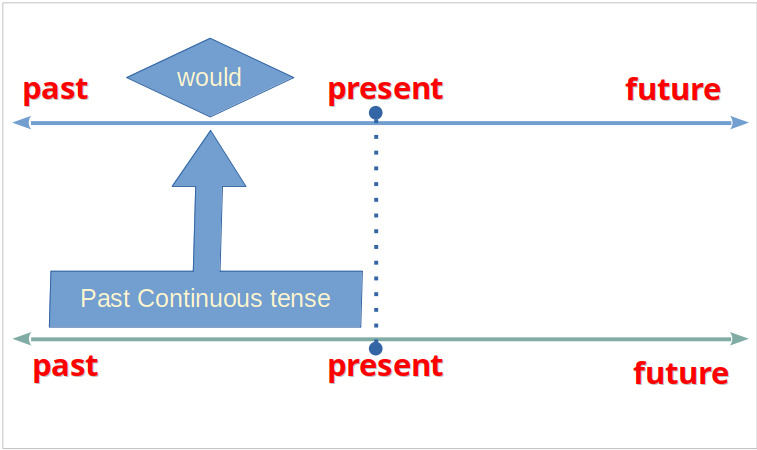
In high school, I `would` do my homework on the bus.
While I was working, I `would` go out to eat more frequently.
In these examples, the speaker is using would to express a past action.
In high school, I `would` do my homework on the bus.
Conversely, would is making a definite claim. Doing my homework on the bus was something that I did do, not just something that I had the ability to do.
Could and would are related, but they mean different things. Could expresses possibility, while would expresses certainty and intent.
Would is the past tense of will.
If you are looking to make a statement of certainty or intent, think to yourself, “I will do that.”
Would is a conditional verb that expresses certainty, intent, or both.
Would is the past tense of will.
H- might
might is the past tense of may.
Many people still think that MAY (present tense) should be used when we talk about a current situation and MIGHT (past tense) should be used when we talk about an event that happened in the past.
I may go home early if I feel tired. (present tense)
She might have taken the keys before going to work. (past tense)
Today, however, these two words are interchangeable. This means that there is no difference between what word you use.
You can say:
I might go home early if I feel tired.
OR
She may have taken the keys before going to work.
a) The Past tense of May
The teacher said that he `might` go home.
I asked him if I `might` see his watch.
Might is used to express:
b) Past tense of Purpose
He ran fast so that he `might` win the race.
She wore high heels so that she `might` look tall.
c) Past Tense of Possibility
The animals thought that tortoise might win the race.
The teacher said that I `might` win a scholarship.
The father said that the mother `might` get late.
d) To express Permission in the Past Tense
The mother said that we `might` take the short cut.
The captain said that we `might` play match.
e) To express some Future Condition
If he gets permission, he might participate in the election.
If she works hard, she `might` clear UPSC this time.
If they perform well, they `might` win the show.
f) To express Good Wishes in the Past
The teacher wished that I `might` do well in the exams.
We wished that our school `might` win the trophy.
Types of Verbs
When looking at the definitions of verb tenses, the terms action and condition appear often.
| A verb is a word showing or expressing action, being, or state of being. What kind of action does a verb show? Some verbs show physical action. |
Action Verbs
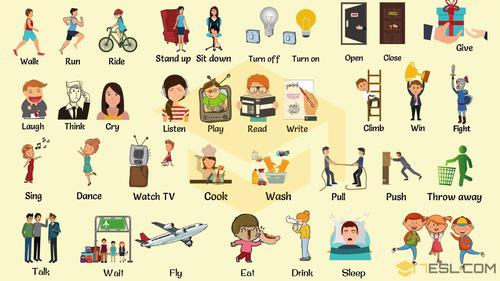
Action verbs like eat, swim, and go refer to an action that takes place.
Examples: to eat, to swim, to write
Non-Action Verbs
As a rule, verbs denoting a state rather than an act have no continuous form, like:
Examples: think, look, understand, know, believe, like, love, belong, prefer, consist, mean, hear, see, etc.
| Non-action verbs tell about states of mind or senses. They do not express physical action. |
- Linking Verbs
Linking verbs, on the other hand, show no action or physical event occurring. They indicate conditions showing what the subject is, or is like. The most common linking verb is to be. It shows being and existing.
| Linking verbs convey a state of being. They link the subject of a sentence with a word that renames or describes the subject. |
Examples: to know, such as to appear, to become, to feel, to grow, to look, and to taste.
To be is the most important linking verb. In this chapter, the following forms of the verb to be appear in examples: am, are, is, was, and were.
- Helping Verbs
When learning about tenses, you used the helping verb to be together with a main verb. To be also performs another job: It can be used as a main verb, just like other verbs. But first, you must learn about all the different forms that the verb to be can take when it is used as a main verb.
Verbs often use other verbs in sentences. Although a main verb represents the important idea of the sentence, it may need a helper to express its full meaning.
| Helping Verbs | Forms |
|---|---|
| to be | am, are, is, was, were |
| to do | do, does, did |
| to have | have, has, had |
| Can | Could |
| Will | would |
| must | - |
Helping verbs help the main verb to make a statement, ask a question, or give a command.
Sources:
- https://www.clarkandmiller.com/4-hacks-to-understand-non-action-verbs-stative-verbs/
- https://www.learngrammar.net/a/inversion-examples-used-after-so-adjective
- https://www.grammar-monster.com/glossary/past_tense.htm
- https://writingexplained.org/could-vs-would-difference
- https://www.myenglishteacher.eu/blog/may-might-difference-examples/
- https://lingbase.com/en/english/grammar/past-modals
En Yeni İçerikler
- 27 Oct 2021 » Functions in the C
- 27 Aug 2021 » Preprocessor directives in C
- 27 Aug 2021 » Past in English Language